Will Office Conversions Actually Produce Affordable Housing? They Should, But State Leaders Must Act
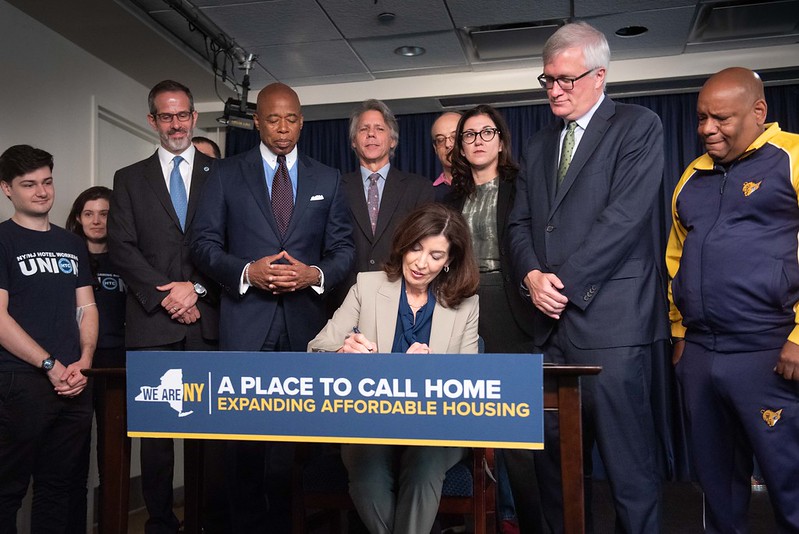
Gov. Hochul signs a bill for hotel to housing conversions (photo: Michael Appleton/Mayor's Office)
In 2016, the City Council adopted mandatory inclusionary housing (MIH), city legislation requiring for the first time that in any rezoning or other regulatory change that created or expanded the right to build apartments — in a neighborhood, or in a single building — at least 20% of the new housing had to be affordable, and affordable in perpetuity.
The foundational concept was simple: if government gives a developer the ability to build more residential units, it is entitled to ask in return for a guarantee that the project will include the mix of incomes that makes the city’s neighborhoods thrive. Prior policies of incentivizing new affordable housing, either through zoning or tax programs, simply had not generated anywhere near the number of units necessary to keep up with demand or promote diverse neighborhoods. With the market continuing to build as many market-rate apartments and luxury condominiums as possible, we knew our city could no longer claim to be a city for everyone if we did not change the rules of the game.
We co-authors had different perspectives from our varied perches — one of us an advocate and nonprofit leader, one the City Council’s chair of the zoning committee, and one the city’s housing commissioner (who worked alongside the deputy mayor for housing and economic development and the chair of city planning). But we all agreed upon one thing: MIH would set a new standard — a floor, not a ceiling, for affordable residential development.
Fast forward seven years. The city was the center of a global pandemic that destroyed families, wiped out people’s livelihoods at an unimaginable scale, and emptied out hundreds of once-bustling business district buildings as office workers went remote. And yet despite the job losses and reports of people leaving the city in droves, rents keep rising and there are even fewer apartments available for low- and moderate-income families. We have a very long way to go on the road to a truly equitable recovery.
But as the state and city lay out plans to make it much easier to convert underused commercial space to residential units, which the city estimated could house tens of thousands of New Yorkers, the notion of mandating affordability has fallen by the wayside. Indeed, the commercial buildings that have already been announced as in the process of converting to residential uses include only market-rate condos and rentals with no affordable units.
Legislation being considered as part of Albany’s big budget package, likely wrapping up in less than a week, would expand the right for developers to convert buildings from commercial to residential — but with zero requirements for permanently affordable units.
The areas that will primarily be affected by the state proposal — downtown Brooklyn, downtown and midtown Manhattan, and Long Island City — currently have very few affordable apartments that middle- and low-income New Yorkers could ever dream of renting. We know that it is expensive and difficult to convert offices to apartments. But we also know it is expensive and not pragmatic for the state and city to be solely responsible for building affordable housing.
We established seven years ago that incentives are no substitute for requirements. We also know from the MIH experience that adding requirements for affordability will not stop construction. More than 10,000 permanently affordable MIH apartments had been approved, with more than 4,000 already completed or under construction, by the end of 2021. Further, because of MIH, high-end neighborhoods like Chelsea/Clinton, Brooklyn Heights/Fort Greene, and Gowanus have already added, or have plans to add, thousands of new homes for low- and middle-income families.
So if New York passes a law that will end up producing thousands of luxury apartments that only the wealthiest can afford, and resulting in zero permanently affordable homes for hard-working regular New Yorkers, then what will we have done?
The solution isn’t rocket science. The city’s MIH requirements must be included in any state legislation that expands rights to commercial to residential conversions.
***
Vicki Been is a former New York City Deputy Mayor for Housing & Economic Development and Commissioner of the New York City Department of Housing Preservation and Development. David Jones is President & CEO of the Community Service Society of New York. Donovan Richards is Queens Borough President and a former member of the New York City Council.
***
Have an op-ed idea or submission for Gotham Gazette? Email This email address is being protected from spambots. You need JavaScript enabled to view it.
Albany: Don’t Tie Our Hands Behind Our Back When It Comes to Fighting Auto Theft and Fraud

On the beat (photo: Benjamin Kanter/Mayor's Office)
With crime continuing to rise in many parts of the state, those of us in law enforcement are doing everything we can to keep people and property safe and secure. And we’ve seen some recent success, especially around reducing gun violence.
But on Long Island, in New York City, and elsewhere, much of the increase is being driven by property crimes, like auto theft.
And yet, despite this worrisome increase, our elected officials in Albany are considering a proposal in the state budget that would gut an important auto-theft-prevention regulation that’s been on the books since the late 1970s and make it harder for those of us in law enforcement to do our jobs.
When an owner of a used car is seeking both collision and comprehensive insurance for the first time, Regulation 79 requires a vehicle photo inspection to be completed within 14 days of the effective date of the insurance coverage. This requirement, for about 8% of used vehicles, covers the small subset that are most likely to be involved in theft or fraud according to data kept by the entity responsible for maintaining the Regulation 79 database. (When the owner is renewing insurance or buying a new vehicle, there is no need to have the car photographed before getting insurance.)
If a car is covered by the Regulation, the owner takes it to one of 3,500 authorized inspection centers around the state. There, a professional will take several photos of the vehicle, including of the VIN sticker, and upload them to the central database to demonstrate that there is no pre-existing damage and the VIN sticker has not been tampered with. This ensures that the car is not stolen nor does it have pre-existing damage that the owner can later claim is new damage, thus committing insurance fraud.
By narrowly targeting the vehicles that are most likely to be stolen or involved in insurance fraud, the regulation helps my colleagues and I fight fraud and theft. If suspicious cars turn up in the database, they are flagged. In 2013, a major auto theft ring was brought down in this way. And if the photos show pre-existing damage, insurers know not to pay out claims for the damage. This in turn means that auto insurance premiums are lower for everyone.
A similar bill that made inspections optional was passed in Albany last year and Governor Hochul wisely vetoed it, observing that the program has “driven down cases of insurance fraud and helped keep rates down for consumers.” Her veto memo said gutting the program would most harm “customers in urban areas who already pay high insurance rates” and who “would likely see their insurance rates increase as a result.”
Indeed, this program has been proven to work. When it was first implemented - during a time of rampant crime - auto theft declined by 7% in New York while increasing in neighboring states.
Proponents of the change in the insurance industry argue that it’s too difficult for customers to get their cars inspected within the two-week grace period. If that’s the case, then maybe the program should be tweaked, as it has been five times in the past. But if we get rid of this program entirely, fraud and theft will increase - driving up costs for people who play by the rules.
When Massachusetts eliminated its program, inspections dropped by about 87%, and collision claims climbed about 55% with premiums spiking by 61%, according to data from CARCO Group, which conducts inspections, and Verisk, another company involved in this work. It wasn’t that Massachusetts residents suddenly became worse drivers, it’s that criminals know how to commit crimes when nobody's looking.
New York shouldn’t follow Massachusetts’ lead. Our program has worked well to protect New York’s consumers. If it needs a tweak so that it’s more user-friendly, that’s fine. But if it’s eliminated, New Yorkers will pay the price.
***
John Becker is President of the Suffolk County Deputy Sheriffs PBA.
***
Have an op-ed idea or submission for Gotham Gazette? Email This email address is being protected from spambots. You need JavaScript enabled to view it.
This Holy Season, State Leaders Should Redouble Efforts to Combat Chronic Homelessness with Supportive Housing
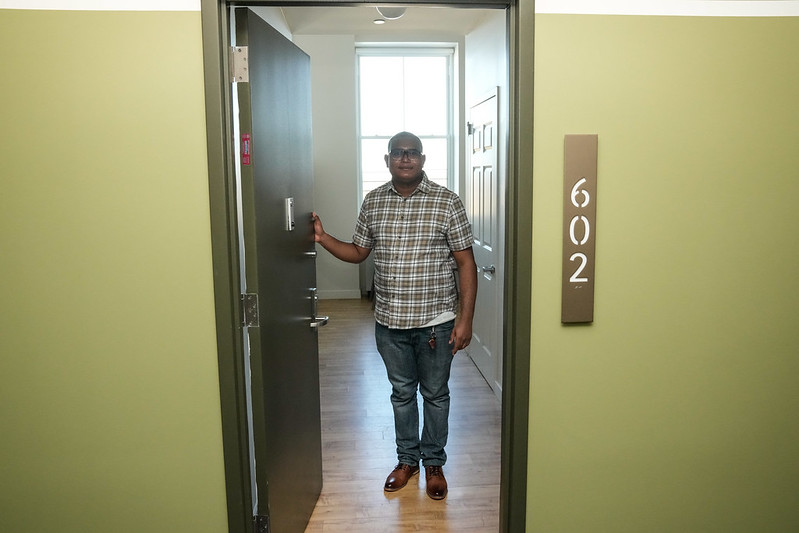
At home (photo: Michael Appleton/Mayor's Office)
This is a holy time for many New Yorkers. Easter, Passover, and Ramadan, all observed this time of year, include important lessons about our collective duty to care for the least fortunate among us.
The number of individuals who need that help is growing. Officials across the state are grappling with how to address a homelessness crisis of epic proportions.
Multiple studies have shown that the best tool available to combat chronic homelessness is to provide individuals not only with a roof over their heads, but on-site services like mental health and substance use counseling to ensure that they can stay safely housed long-term.
New York pioneered this supportive housing model, launching innovative and cutting-edge programs in the early ‘80s that brought together faith leaders, social service providers, and nonprofit organizations in a unique and never-before-seen collaboration. But as the need for more supportive units grows, developing them is becoming more difficult – and expensive.
In 2016, the state made an historic commitment to develop 20,000 supportive apartments by 2031 by way of the Empire State Supportive Housing Initiative (ESSHI). But the price tag for building, land acquisition, labor, and supplies has risen exponentially since then.
The cost of maintaining existing supportive housing developments has risen too, but the state’s funding rates have not kept up, essentially rendering ESSHI obsolete — especially in New York City, where close to 69,000 individuals – including more than 21,000 children — sleep in municipal shelters every night, and thousands more are on the streets, in parks, and in the subway system.
It is imperative to the future of the ESSHI program that state lawmakers and the governor this year raise the per-unit rates for services and rent subsidies from $25,000 per unit to $35,000 per unit. The total cost to the state of this important investment would be just $14 million a year – a small fraction of the $227 billion executive budget Governor Kathy Hochul proposed.
The difference would be immediate and palpable: jumpstarting the development of both supportive and affordable housing. Governor Hochul has already recognized the desperate need for more affordable housing, announcing a strategy to build 800,000 new homes over the next decade.
Catalyzing the creation of more ESSHI units is especially needed for certain groups of people who otherwise would not qualify for this housing. The program uniquely allows nonprofits to build housing for families escaping domestic violence and for individuals re-entering society after incarceration. For both these extremely vulnerable populations, ESSHI is the only option for safe, stable housing with wrap-around services.
The impact of supportive housing for families escaping domestic violence is incalculable. The ability to quickly access a new place to live and the services necessary to stay housed is key to the success of victims seeking to start a new life – for parents and children. And providing supportive housing for a formerly-incarcerated individual is vastly more affordable to the taxpayers than the cost of keeping them behind bars: $1,500 per person, per day at Rikers Island, according to the New York City Comptroller’s Office.
Supportive housing enables individuals and families to rebuild their lives in dignity and safety. It also can help transform formerly blighted and underutilized buildings and underdeveloped lots, providing a broader benefit to the local community.
It is fortuitous that this holy season – a time of rebirth and recommitment to the tenets of kindness and caring for those less fortunate than we are – coincides with the closing days of debate over the state budget in Albany. It is our fervent hope that lawmakers and the governor take this opportunity to do what’s right and invest in supportive housing – a proven model that has the potential to make an even bigger difference for the people who need it and our entire state.
***
The Rev. Ann Marie Witchger is Associate Rector and Chief of Staff at the Church of the Heavenly Rest on the Upper East Side. Evan A. Davis is chair of the church’s Homeless Working Group and was chief counsel to Governor Mario M. Cuomo.
***
Have an op-ed idea or submission for Gotham Gazette? Email This email address is being protected from spambots. You need JavaScript enabled to view it.
We’ve Lost Children in Preventable Traffic Crashes; Albany Must Let New York City Control Its Streets
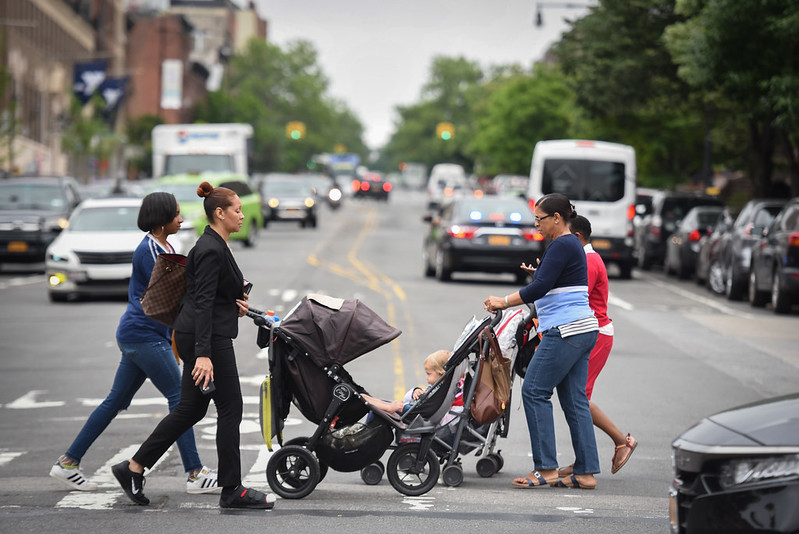
Pedestrians on the move (photo: Michael Appleton/Mayoral Photography Office)
Blake Gary was 22 for only seven days.
His room was still filled with birthday streamers and balloons when he left to celebrate with friends. Later that night, he was killed in a car crash, the blue Toyota Corolla twisted around a fire hydrant, flipped upside down, and snapped in two in Hollis, Queens.
At the morgue at Queens County Hospital, we were forced to identify Blake, our family’s oldest child and only son, from just a picture. It’s been almost six years, and we’re still waiting for his belongings — his clothes, shoes, and bag from that night, trapped somewhere in the bureaucracy.
The crash unstitched a community and unraveled a family, but it wasn’t an accident: the street is steep, and consistently and routinely dangerous. Crashes happen here, and across the five boroughs, regularly — someone is killed in a crash on New York City streets every 33 hours. Four years before Blake’s crash, 12-year-old Sammy Cohen Eckstein was killed by a speeding driver on a similarly deadly street. Sammy was just two months shy of his birthday, preparing for his Bar Mitzvah and studying for high school entrance exams – until October 8, 2013.
It doesn’t have to be this way. We can design and build streets and intersections that strengthen our communities — and we can start by passing Sammy’s Law, named for Cohen Eckstein, allowing New York City to control its own speed limits.
Right now, Albany lawmakers decide how fast New York City drivers can travel on New York City roads. New Yorkers have no control over our own speed limits through our local government, even on roads we know are dangerous.
The status quo is deadly. Across the five boroughs, speeding is a major factor in four out of every five crashes that kill people in cars — 30% of pedestrians struck by motor vehicles at an impact speed of 25 MPH will sustain serious injury, and about 12% will die. Even just slightly lower speeds can make a big difference: a pedestrian is four times more likely to be killed by a car going 30 MPH than one traveling 25 MPH.
Fortunately, safer speeds work. Slowing from 30 to 25 MPH reduces the chance of a fatal crash by 78%, and lowering speeds from 25 to 20 MPH has led to a 14% reduction in injurious crashes and a 31% reduction in injuries for both drivers and passengers. Lower speed limits in New York City have already contributed to a 36% decline in pedestrians killed.
New Yorkers support local control for city speed limits, and 72% of New Yorkers believe the City, not Albany, should have the authority to set its own speed limits. The majority supports slower, safer speeds — 68% of voters said they would support seeing the speed limit lowered from 25 to 20 MPH on residential streets near their homes.
We can make this a reality — and all eyes are on Assembly Speaker Carl Heastie and his colleagues to make it happen. Both Governor Hochul and the State Senate have shown leadership on this, and included legislation for lower speed limits in their proposed budgets, but we need Albany to step up as a whole and include this critical bill in the final state budget — which is being negotiated right now and due by or around the April 1 start of the new state fiscal year.
Safer speeds could have saved Blake’s and Sammy’s lives – but if you drive by 100th Avenue near 205th Place in Queens, you’d never know. We can’t put anything down to keep Blake’s memory alive; the crash happened on someone else’s private property, so there’s no sign, no cross, no memorial, nothing tangible to remind the world Blake Gary existed. The street itself remains deadly — bent and steep, without even a speed bump, a lower speed limit, or a speed safety camera.
It’s said often because it’s true: losing a child is the worst thing that can happen to a parent. The darkness and the suffocating grief is crushing and all-encompassing; it feels impossible to breathe, eat, sleep, survive. Slowly, we began to focus on remembering Blake and Sammy. We joined Families for Safe Streets support groups, where we built lanterns and jewelry boxes and fridge magnets covered in our children’s likeness, their favorite color, their memory. It was here where we met each other and other parents with pain shaped like ours, and we started to demand better, together.
Our children’s deaths were preventable. We can stop this compounding pain, and instead protect other families from losing their children in the same way. The State Assembly must join the State Senate and the Governor in honoring our children by passing Sammy’s Law and allowing our city to control its own speed limits.
***
Denyze Gary and Amy Cohen are two members of Families for Safe Streets and mothers who lost their children to traffic violence. On Twitter @NYC_SafeStreets.
***
Have an op-ed idea or submission for Gotham Gazette? Email This email address is being protected from spambots. You need JavaScript enabled to view it.
The Most Important Infrastructure Project You’ve Never Heard Of: Improving the Massive $52 Billion Flood Protection Plan for NYC
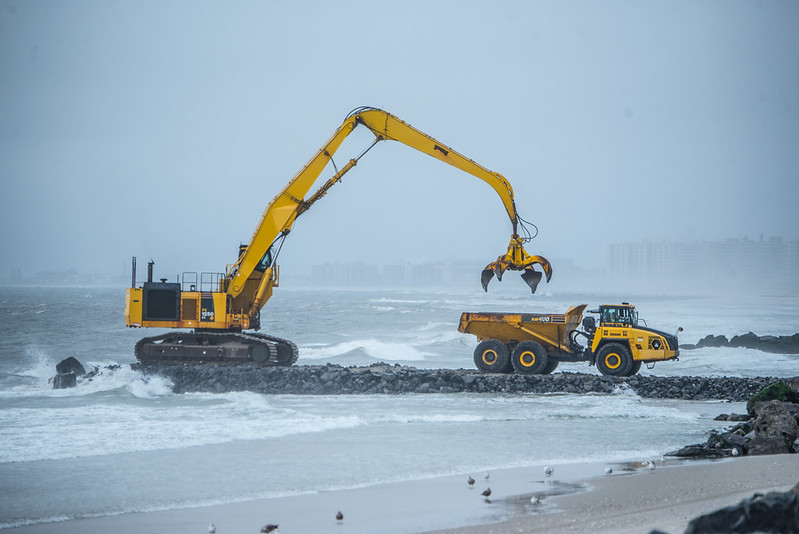
Storm barriers (photo: Michael Appleton/Mayoral Photography Office)
This week, on the heels of the latest sobering United Nations climate change report, the next round of public input will close for one of the largest public infrastructure projects ever to be considered for the New York City region.
The U.S. Army Corps of Engineers is seeking feedback on its $52 billion proposal to protect New York City and the surrounding areas in New York and New Jersey from devastating coastal storms like Hurricane Sandy. And although this project has been progressing for almost a decade, there has been limited attention on this massive initiative, despite its potential to impact millions of New Yorkers and shift the way we interact with our waterfront. It’s time for New Yorkers to secure our future by making sure the Army Corps gets this right.
Hurricane Sandy was the worst natural disaster to ever hit New York City. During the storm, 44 New Yorkers lost their lives, nearly 70,000 homes were damaged, and millions of residents lost power for up to two weeks. Even after the storm subsided, it left devastating impacts in its wake. Thousands of New Yorkers were displaced from their homes, critical public and private infrastructure was damaged, and entire communities were upended. In total, Hurricane Sandy inflicted an estimated $19 billion in damages and lost economic activity across the city. And it showed us just how vulnerable our city is in the face of climate change.
These risks are only growing. Sea levels in the city have already risen by a foot over the last century, and the rapid acceleration of sea level rise over the coming decades means our coastal flooding will only get more frequent and intense. Temperatures are also rising. Intense rainfall events like Hurricane Ida are becoming more common. And the City projected in 2013 that by the 2050s, a Sandy-like storm could cause $90 billion in damage and economic loss – nearly five times Sandy’s impact.
That’s why the Army Corps’ work is so important as one piece of a comprehensive set of preparations for our growing climate risks. This $52 billion conceptual proposal, part of the New York and New Jersey Harbor and Tributaries Study (HATS), is already nearly a decade in the making and assesses a number of potential flood protection measures for an area covering over 2,100 miles of land and affecting nearly 16 million people across the two states. In its tentative recommendations (called Alternative 3B), the Army Corps proposes a series of storm surge barriers and other flood protection measures in key points throughout the New York and New Jersey waterways. Once a concept is approved and funding is secured, the Army Corps will lead a design process through 2030, with measures in place by 2044.
This project presents a once-in-a-lifetime opportunity to install resiliency infrastructure of this scale, which is critical to protect our city against our growing climate risks. As New Yorkers, we must come together to demand that the Army Corps provide these measures as soon as possible and ensure that the designs are improved without adding delays to the process, since every year without flood protections is another year New York City remains at risk of extreme climate impacts.
First and foremost, these flood protection measures must be integrated into the fabric of our city and enhance our public spaces along the waterfront. For example, seawalls can also incorporate an elevated promenade with green space, so that New Yorkers have waterfront access and new public spaces to enjoy. We have already seen other climate resiliency efforts incorporate features and amenities like these for communities to enjoy, such as with the Rockaway Boardwalk and the East Side Coastal Resiliency project.
The designs must not only protect us from storms, but should also clean our water, enhance biodiversity, and guard against sunny-day flooding caused by sea level rise by maximizing the use of nature-based solutions. Green infrastructure such as wetlands and oyster reefs, though insufficient on their own as resiliency measures to protect our city, are a critical part of a holistic and smart resiliency strategy.
In order for this project to be successful, the design process must be community-centered. The Army Corps must meaningfully and thoughtfully engage local and historically underserved communities in impacted neighborhoods. This may include utilizing engagement strategies that go beyond what is standard procedure for federal public engagement processes, such as holding events during non-traditional business hours, providing childcare, or seeking input in locations where communities already meet.
The Army Corps must also prioritize environmental justice by ensuring that historically underserved communities are meaningfully involved, valued, and protected. Environmental justice is too-often devalued in federal cost-benefit analyses, but President Biden’s Justice40 demands a renewed commitment to environmental justice as we confront our climate crisis.
The Army Corps proposal is an unprecedented opportunity to bring together communities and federal, state, and local governments to invest in the future of New York City. We must improve the design for New Yorkers, while advancing without delay the critically-needed protections that this project could bring to our city as the climate changes. The future of our city depends on it.
***
Grace Rauh is the Executive Director of the 5BORO Institute, a think tank bringing together leaders across sectors to find innovative solutions for New York City. Daniel Zarrilli is the former Chief Climate Policy Advisor to the NYC Mayor and a 5BORO board member. On Twitter @GraceRauh & @DZarrilli.
***
Have an op-ed idea or submission for Gotham Gazette? Email This email address is being protected from spambots. You need JavaScript enabled to view it.
Don’t Let SNAP Break: Action Needed at All 3 Levels of Government So Kids Don’t Go Hungry
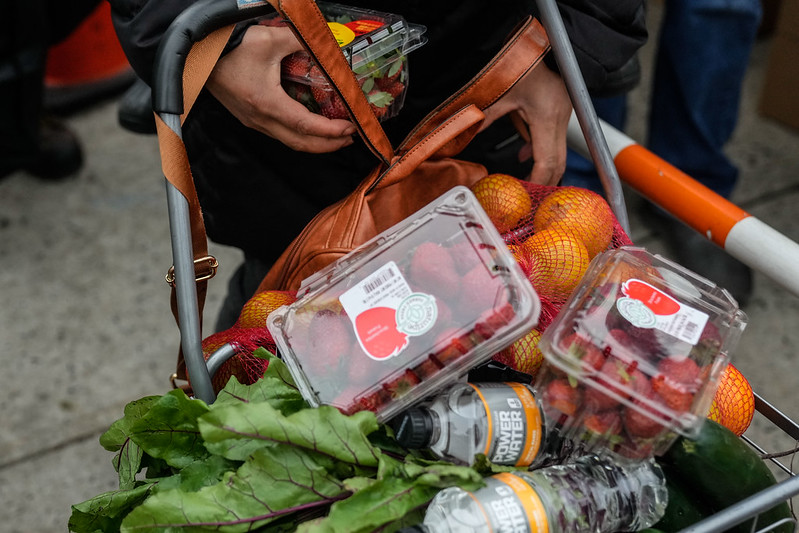
Access to food (photo: Michael Appleton/Mayoral Photography Office)
Imagine having $100 less every month to buy groceries.
Millions of New Yorkers are now facing that painful reality. They’ll feel it in a thousand ways, big and small. A child who comes to school without breakfast. A mom who skips a meal so her kids have enough to eat. A refrigerator that’s empty because money ran out before the end of the month.
March marked the end of a pandemic-era lifeline that provided extra money for food. Despite record-high prices for basic household necessities, families that live paycheck to paycheck have abruptly been forced to make do with at least $95 less each month.
This immediate cut will hurt.
But as an advocate fighting to end child hunger, I’m worried that an even bigger danger is coming at us.
The more we hear about the debt ceiling fight unfolding in Washington, the clearer it’s become that the millions of kids who rely on food assistance are at greater risk. One of the most important programs we use to fight child hunger is in danger of breaking.
The Supplemental Nutrition Assistance Program (SNAP) is one of the most effective tools we have to feed kids. The average family in the program receives about $230 a month for groceries, usually on a debit card they can use at the supermarket. SNAP has never been enough to cover the full cost of food, especially in places with a high cost of living like New York. But it’s still an enormous help.
Nearly 3 million New Yorkers rely on SNAP to make ends meet.
Earlier this month, lawmakers in the U.S. House of Representatives introduced the America Works Act, a punitive and counterintuitive proposal, which would place limitations on SNAP by tightening work requirements for so-called able-bodied adults without dependents. This proposal would harm individuals who already face obstacles to work – like a lack of stable housing and access to transportation – and doesn’t take into consideration those with undiagnosed physical or mental limitations. It also seeks to impose these stricter requirements on parents and caregivers of children ages seven and older, completely ignoring the realities facing many families on SNAP. We need legislation that helps people put food on the table – not makes it harder to do so.
We desperately need New York’s congressional delegation, especially Senate Majority Leader Schumer and House Democratic Leader Jeffries, to stop any further cuts to SNAP in their tracks. Just like seniors’ health care or Social Security has become a political red line, so should the programs that feed children.
Saving SNAP should be a bipartisan priority, equally important to our leaders from urban and rural districts, upstate and downstate.
But Washington isn’t the only place we need bold action to protect food aid. We need to do more here on the ground in New York as well.
Here in New York City, agencies like the Human Resources Administration (HRA) represent the front door to the SNAP program, processing applications from families. But over the last year, we’ve seen that door close on families in need.
There’s been a troubling rise in the amount of time it takes families to get approved for benefits. The standard processing time has always been within a month. But over the last year, nearly half of all applicants were stuck in the queue waiting longer.
Those are our neighbors who may have lost a job or suffered a catastrophic illness, who are left in limbo without the immediate help they need to cover expenses. New York City needs to fast track hiring for these roles and fully fund the staff and related services needed to handle applications promptly. This has to happen in the coming budget.
And we can make sure that families don’t get scammed out of their benefits. The plague of “SNAP skimming” has surged in recent months. It’s a new kind of identity theft that’s stealing food money from families who need it most. We were grateful that the federal government has begun steps to reissue some of those benefits and excited to see legislation introduced in the State Assembly that would reissue certain benefits like SNAP for recipients who were victims of skimming or lost benefits through fraud.
SNAP is too important to too many New Yorkers to be skimmed, delayed, or cut. We have to protect it for the millions of our neighbors who depend on it. Now is the time for elected officials from New York, at every level of government, to protect this vital program.
***
Rachel Sabella is Director of No Kid Hungry New York. On Twitter @RachelS23 & @nokidhungry.
***
Have an op-ed idea or submission for Gotham Gazette? Email This email address is being protected from spambots. You need JavaScript enabled to view it.
3 Ways the Next New York State Budget Must Lift Up Communities of Color

Economic development with a focus on MWBEs (photo: Kevin P. Coughlin/Governor's Office)
As Governor Hochul and lawmakers in Albany work toward a new state budget, meaningful conversations are occurring on a wide range of critical issues from housing to workforce development to sustainability to health care and more. New York has long been at the forefront of advancing consequential progressive policies in these and other areas. But given the current political dynamic and the historic diversity of our state government, we have a tremendous opportunity to leverage this important process to address long-standing inequities that have persisted across New York.
Take housing, for example. We know that New York is in a housing crisis. Governor Hochul has proposed an ambitious plan to create 800,000 new homes across the state over ten years. While some suburban lawmakers have pushed back on the Governor’s Housing Compact, falsely claiming it will be the end of single-family homes, the plan must move forward.
But it also has to go further.
Homeownership has been a critical driver of generational wealth, but that door was closed to Black, Latino, and Asian New Yorkers historically. To help close the racial wealth gap, the state must restore funding for the Homeownership Protection Program (HOPP) and introduce other mechanisms to grow and protect homeownership, particularly among New Yorkers of color.
We also can’t forget about our existing affordable housing stock. That means replacing the expired J-51 program with a viable alternative that will facilitate the preservation of and needed capital improvements to affordable rental homes.
When it comes to our fragile economic recovery, small businesses – especially minority- and women-owned businesses (MWBEs) – continue to lag behind. New York State has the ability and responsibility to make it easier for minority- and women-owned business enterprises to do business, including by enacting the Governor’s proposal to increase the discretionary purchase threshold for MWBEs to $1.5 million from its current levels of $1 million in New York City and $500,000 across the rest of the state.
Finally, we have seen how low-income New Yorkers and New Yorkers of color continue to be worse-off than their neighbors when it comes to the quality of the air and water in their communities, and when it comes to health outcomes.
In recent months, New York State Homes and Community Renewal announced the Climate Friendly Homes Fund (CFHF), which will invest $250 million to electrify at least 10,000 units of multifamily housing in economically disadvantaged communities. This is a historic step, and one New York should expand upon. For the sake of future generations of New Yorkers, it is imperative the state identify and implement other promising opportunities to make our communities more sustainable.
This month is vitally important in terms of determining who we are as a state and where we are going in the future. As the leader of a non-profit organization that has invested hundreds of millions of dollars in recent years to create affordable housing, help New Yorkers buy their first homes, support small businesses, and expand sustainability measures in communities from New York City to Buffalo, I know what it will take to achieve all we’ve talked about. But it is so important that we succeed, and I am confident we can get it done together.
***
Valerie White is the Senior Executive Director of LISC NY. On Twitter @LISC_NYC.
***
Have an op-ed idea or submission for Gotham Gazette? Email This email address is being protected from spambots. You need JavaScript enabled to view it.
New York’s Child Tax Credit Choice

Gov. Hochul in the classroom (photo: Kevin P. Coughlin/Governor's Office)
When does childhood begin? For at least a half-century, that question has been one of the most contentious in American politics, with participants in debates over abortion and reproductive rights variously arguing that conception, viability, birth, or any number of other milestones marks the point at which a fetus becomes a child entitled to the full protection of the law.
But pretty much everyone agrees that whenever childhood begins, it’s well before age 4.
Yet under New York law, children under the age of 4 are categorically ineligible for the state child tax credit, making New York the only state in the nation with a child credit that excludes infants and toddlers. Both the State Senate and Assembly endorsed proposals this month that would fix that flaw, but Governor Kathy Hochul’s budget for fiscal year 2024 maintains the exclusion of New York’s youngest children from the credit, which maxes out at $330 per year.
As the governor and Legislature race to finalize the fiscal year 2024 budget by the April 1 deadline, Hochul and state lawmakers face a choice: Will they seize the opportunity to extend the full child credit to New York’s youngest and poorest kids? Or will infants and toddlers lose out once again to well-heeled industry groups in the Albany budget scrum?
The exclusion of infants and toddlers dates back to 2006, when New York lawmakers first enacted a state credit for families with kids in the 4-to-16 age range. No one has offered a plausible rationale — other than cost saving — for the exclusion. Social science research indicates that early childhood is the period in which material deprivation is most harmful to a child’s long-term development — and thus the life stage at which low-income families are most in need of financial support.
New York’s child credit has another curious feature: low-income families with kids ages 4 through 16 receive a smaller amount than middle- and upper-middle-income families with children in that age range. As a result of this “phase-in” — which the Senate and Assembly proposals would leave in place — a family with two children must earn at least $16,333 to receive the full credit. The neediest families — those with no income — receive only $100 per eligible child.
The Center on Poverty and Social Policy at Columbia University estimates that extending the credit to children under four and eliminating the phase-in feature would cost $270 million to $320 million per year. That’s a drop in the bucket relative to Hochul’s $227 billion budget plan — well less than 0.2% of the total.
In the short-term, that investment would make a meaningful dent in New York’s childhood poverty problem, lifting roughly 40,000 kids — and their families — above the poverty threshold, as defined by the Census Bureau’s supplemental poverty measure.
And in the long-term, as the Columbia researchers showed, child tax credits for low-income families yield benefits to society that far exceed the costs. Kids whose families receive credits and similar cash transfers are more likely to finish college and less likely to end up in prison. Their lifetime earnings rise as well.
So why has the governor rebuffed proposals to expand the state credit thus far?
Hochul hasn’t said she opposes the extension of the credit to infants and toddlers, and she hasn’t defended the phase-in feature that prevents low-income families from claiming the full amount. Instead, she has decided that other tax and spending items take priority — such as her proposal to increase the state’s film and television tax credit by $380 million a year.
It’s no exaggeration, then, to say that the governor is putting film and TV producers before infants and toddlers. For the price tag of her film and TV tax incentive plan, she could extend the child credit to the youngest New Yorkers, eliminate the income phase-in, and still have tens of millions of dollars to spare.
Unfortunately, infants and toddlers can’t hire high-priced lobbyists to do their bidding in Albany. And low-income families lack the political power that industries like film and television wield.
Hopefully, the governor will decide that even if the political benefits are small, there is a compelling moral case for extending the child credit to low-income families with young children. If she decides instead that favored industries should take priority over low-income families, she might not face significant political blowback. But she will have to face her conscience.
***
Daniel Hemel is a law professor at New York University. On Twitter @danieljhemel.
***
Have an op-ed idea or submission for Gotham Gazette? Email This email address is being protected from spambots. You need JavaScript enabled to view it.
Albany: Keep the Cameras Rolling, Expand the New York Film Credit
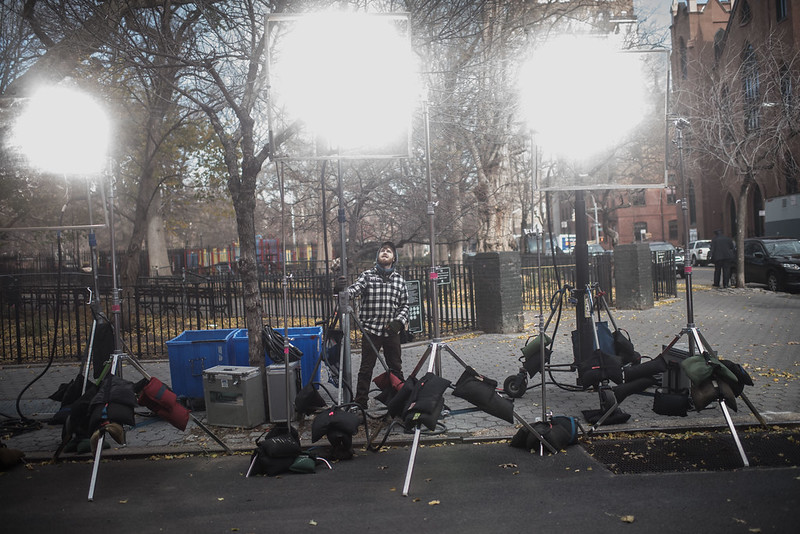
At the shoot (photo: Michael Appleton/Mayor's Office)
Working in this industry for over two decades, I’ve seen what it takes for a viral television show or blockbuster film to be made. While people normally consider the creatives of the film industry — actors, writers, and producers — there are thousands of jobs, just like mine, behind the scenes that help small and large-scale productions go off without a hitch. While the film industry itself employs tens of thousands of people in New York, the larger, parallel ecosystem that helps these glamorous productions run like a well-oiled machine, employs even more.
Part of what has helped build film and TV production into a multi-billion-dollar industry in New York is the New York Film Tax Credit program, which incentivizes production companies to invest in New York by choosing to film here. Over the past few decades, this program has been critical in creating quality jobs for New Yorkers, jobs that are largely unionized, high paying, and many do not require a four-year degree. That’s why it’s absolutely critical that state government in Albany pass Governor Hochul’s film tax credit expansion, as it will help to support tens of thousands of high-quality jobs that New Yorkers need.
Research from the New York Production Alliance and NYU Wagner’s Rubin Center for Transportation Policy and Management highlights how directly the economic impacts of New York’s film industry have been tied to the Empire State Film Production Tax Credit program.
Prior to the credit’s introduction in 2004, New York struggled to keep up with competition from other states and countries offering lower costs for film production. But from 2004-2018, statewide wage-and-salary employment in film and TV production rose by 52.3%, resulting in an increase of 17,000 jobs. With an increased demand for such roles as the sector has grown in the state, Governor Hochul’s tax credit plan also allocates funds to maintain and expand the high-quality workforce we have here in New York, including career development programs to make film sets reflect the diversity of New York.
Additionally, the enactment of the tax credit helped to pave the way for increased investment in production facilities, both old and new. This has resulted in the creation of over 6,000 jobs (both direct and indirect) in 2019-2022 alone.
As these tax credits offset the higher costs of these productions, they also result in direct investment in the communities in which they film. This supports the hundreds of small businesses and jobs that exist in order to keep the productions up and running. From restaurants that cater meals to supplies to build sets, there are many necessities for the film industry to execute projects.
I’ve seen how resilient the New York City film industry is in the darkest days our city has lived through. While many industries in 2008 saw a downturn, film went up over 50%. While Hurricane Sandy temporarily halted production and live audience filming, the industry came back stronger than ever less than a week after it made landfall. Most recently, in light of the COVID-19 pandemic, which kept people apart for months, film came back earlier than a number of other industries, thanks to the implementation of extensive health and safety protocols. But, none of this happened overnight, and it is attributed to thousands of New Yorkers across the film industry that supported one another, bringing entertainment to those around the country and the world.
State leaders: let’s not let the curtain go down on an industry that has brought such economic and cultural value to our state.
***
Flo Mitchell-Brown is the Head of Industry Engagement at Extreme Reach and the chair of the New York Production Alliance. On Twitter @NYPAnys.
***
Have an op-ed idea or submission for Gotham Gazette? Email This email address is being protected from spambots. You need JavaScript enabled to view it.
He Won Key New York Environmental Battles That Reverberate Today: Celebrating Al Butzel
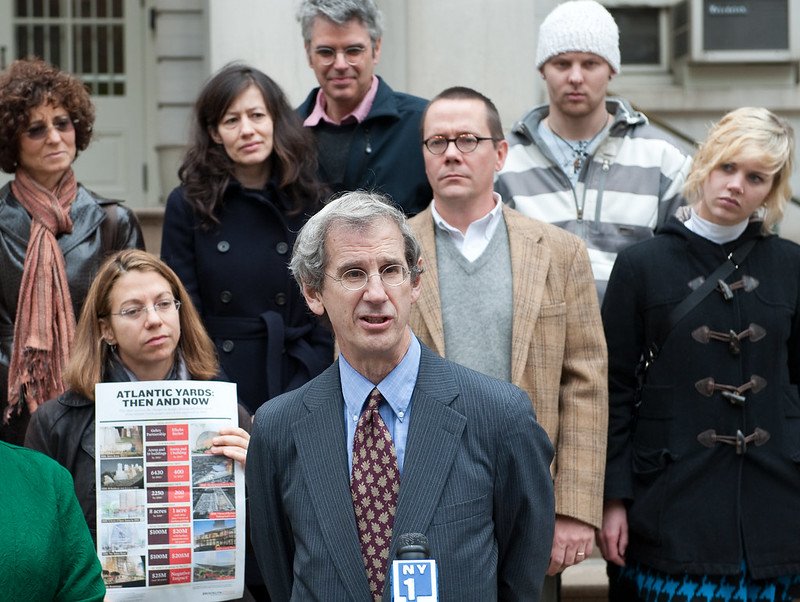
Al Butzel at City Hall in 2009 (photo: Tracy Collins @threecee)
A towering figure in New York environmental law for the past half-century, Albert K. Butzel is relocating to Seattle to be closer to family. Al and his wife Brenda depart this weekend. We worked alongside Al over the years and offer our reflections on his enormous impact below.
First, Charles Komanoff, a policy analyst who runs the Carbon Tax Center and is active in the campaign to bring congestion pricing to New York. Then, attorney Michael Gerrard, who practiced environmental law full-time in New York for 30 years and since 2009 has been a professor and faculty director of Columbia Law School's Sabin Center for Climate Change Law.
***
From Charles:
I met Al nearly 50 years ago. It was late 1973, a fraught but exciting time. My stint as energy analyst at New York City’s Environmental Protection Administration (as the Department of Environmental Protection was then called) was coming to a close, with the technicolor mayoral torch of John Lindsay passing to the stolid clutches of mayor-elect Abe Beame.
I had a secret to share with Al, concerning a contested power project Con Edison had been trying for a decade to build in the Hudson Highlands 50 miles north of mid-Manhattan. Al was attorney for the gentry who had won the landmark 1965 “Scenic Hudson” decision granting citizens legal standing to defend natural or historic places. Con Ed had subsequently modified its design to mitigate the project’s intrusion on Storm King Mountain. After years of stasis, ground-breaking was imminent.
Lindsay’s environmental agency was overseeing the permitting. Along with an attorney there, Ken Semmel, I had devised an ingenious alternative, pairing combustion turbines with heat-recovering generators making both electricity and steam. Our configuration might actually compete with the Con Ed plan on cost, efficiency, and reliability. Around Thanksgiving, City Hall cleared the agency to send Con Ed our plan for comment. It was time to open a public channel.
I contacted Al. Meeting was a bit like looking in a mirror. We were probably both surprised at the other’s relative youth. I was 26 but looked closer to 20. Al, in his mid-30s, was just as skinny and still boyish. He was rumpled, easy-going, and affable. He spoke with a lilt, sometimes laughing at his own words, but he was steely and, at the end of the day, no-nonsense.
I described our concept. Al quickly grasped that our plan appeared to beat Con Edison at its own game. It would burn less oil, make less pollution, be buildable in stages, and, sited in Manhattan and the Bronx, be more reliable. It may have been Al who deduced that municipal tax revenues from our plan could neutralize criticism that we were advancing the economic interests of wealthy landowners.
That day launched a collaboration lasting half-a-dozen years. In short order, Al arranged for me to present my Storm King alternative to a Washington audience that included Westchester member of Congress and conservationist Dick Ottinger — and to leak our analysis to New York Times reporter Pete Kihss, who cornered Con Ed into preparing a response. When no deep flaws emerged, our plan gained the support of the state attorney general, in mid-1974.
From then to 1980, the Storm King project died a slow death, its demise multiply determined. New York’s near-bankruptcy, cratering power demand, Con Ed’s 1977 transmission-caused blackout, fears of larval striped bass destruction from Storm King’s massive water pumps, all played a part. Ken’s and my labors possibly rate an historical footnote.
Al’s work on Storm King as litigator and strategist was a different matter. For years after the “Scenic Hudson” decision, when Con Ed still had economic muscle to push the project forward, he kept the utility off-balance. His unflagging confidence gave Hudson River defenders faith we could prevail. Al always insisted that a better solution lay in store that wouldn’t mar the Hudson Highlands. He was right.

Storm King Mountain (photo: Charles Komanoff)
***
It wasn’t long before the two of us took up an even bigger issue, nuclear power. The Long Island Lighting Company was juggling two reactor ventures on Suffolk County’s north shore. Shoreham had a construction permit from the federal Atomic Energy Commission, but Jamesport, a much larger project 20 miles east, still faced public hearings.
It was 1975, four years before anti-nuke activism would be turbocharged by the Three Mile Island meltdown in Pennsylvania. Oil-dependent, tech-rich Long Island was hospitable to nukes. Ann Carl, a biologist from the north shore village of Lloyd Harbor, had other ideas. Channeling dissidents like Rachel Carson and Jane Jacobs, Ann considered nuclear power expensive and unnecessary and wanted Lilco to prioritize energy conservation and efficiency before Jamesport. She hired Al, and Al retained me.
It didn’t take us long to apply what we had learned from our Con Ed work. Knowing that Storm King depended on cheap, surplus nuclear electricity to overcome power lost from pushing Hudson River water uphill to a reservoir each night, we peered behind the atomic curtain. Rather quickly, we saw that the nuclear power industry, a juggernaut from the outside, was reeling from cascading regulatory changes and delays that piled up carrying costs. On paper, spiraling oil prices validated more nuclear power from plants like Jamesport. In real life, the combination of costly oil-fired power and the struggle to build two reactors at once pushed up Lilco’s electric rates, driving down demand and drying up financing.
These critiques, obvious in hindsight, were heretical at the time. Al never shied from them. I’ll say he was a born contrarian, a lover of undisturbed nature, and a spoiler for a good fight. Riding into battle with Al, you had the edge. There seemed no argument he couldn’t win, no trap he couldn’t wriggle out of, no adversary he couldn’t outwit. Not just the smartest guy in the room, he was the most effective.
***
From Michael:
When I graduated from law school in 1978 I joined the boutique environmental law firm Berle, Butzel & Kass. It mostly represented community groups fighting projects that threatened to worsen local pollution.
Along with Peter Berle, who would later become state environmental commissioner, Al taught me how to try a case. Two were particularly memorable. The first concerned a proposed U.S. Postal Service vehicle maintenance garage in Manhattan’s Chelsea neighborhood. Al was the lead lawyer, and he contended that the Postal Service's environmental impact assessment was inadequate because, among other things, it failed to consider an alternative site that had been proposed by a young, flamboyant real estate developer named Donald Trump.
The federal judge hearing the case stopped Al's argument at that point and said, at some length, that Trump was a blowhard who had never really built anything and never would, and his proposals should not be taken seriously. Al stood there stoically while the judge lashed into him, and then proceeded calmly to try the case.
The other, far weightier case concerned Westway. For close to a decade, Al was the lead lawyer fighting this proposed underground interstate highway along the Hudson River on Manhattan’s west side, which opponents branded “a massive real estate development project masquerading as a highway.”
He first contested it on the grounds that it would bring more traffic and therefore air pollution into Manhattan’s congested streets — an argument developed by his expert, Brian Ketcham, the engineer who had devised a plan in the waning days of the Lindsay administration to meet federal clean air standards through a combination of policy carrots and sticks designed to curb motor vehicle traffic.
Ketcham’s thesis was an early expression of the paradigm now known as induced traffic, which holds that expanding road capacity temporarily makes driving easier and more efficient, up until the increased traffic volumes cancel the initial boost in vehicle speeds. This argument is today nearly gospel (except among hardened, senior highway officials), but in the 1970s it was no match for the ridicule from the state transportation officials pursuing Westway.
The trial on the induced traffic issue took place before a hearing officer of the New York State Department of Environmental Conservation in one of the twin towers of the original World Trade Center. The lead lawyer on the other side was Frederick A.O. Schwarz Jr., a legendary trial lawyer from the even more legendary law firm of Cravath, Swaine & Moore. (Ordinarily the state attorney general’s office would have been representing the state, but the attorney general at the time, Bob Abrams, opposed Westway and made the state hire outside counsel.) The first cross examination I ever conducted was of an expert witness called by Schwarz; that was intimidating, to say the least, but Al coolly coached me through it.
One of the major issues in the case was whether there was enough parking capacity in Manhattan’s commercial garages to hold all the cars Al said would be attracted by the highway; if there weren’t, maybe they wouldn’t come. The official numbers in the city’s records indicated there were enough, but Al didn’t trust them. So Al spent several weeks riding around Manhattan on his bicycle, stopping at every parking garage and writing down the number of spaces it had posted. The other partners in the firm questioned whether this was the best use of a senior lawyer’s time (when I became a senior lawyer myself, I realized that of course it wasn’t), but Al was insistent on getting the numbers right.
The hearing officer (a retired upstate judge) recommended that the permit be granted; the DEC Commissioner (reporting to Governor Hugh Carey, a strong supporter of Westway) signed the permit. Thus ended our traffic case.
Al then pivoted to the aquatic biology he had learned in the Storm King dispute. To Judge Thomas Griesa of the federal district court for the Southern District of New York, who was hearing the lawsuit, he brought fisheries biologists who testified that creating the 220 acres of new landfill to undergird Westway would grievously harm the habitat of the striped bass that spawned upriver before leaving the Hudson to populate New York and New England bays and sounds. Under Al’s questioning, the biologists stressed the potential devastation, highlighting the highway’s appropriation of ten percent of the river’s expanse along Manhattan’s west side.
The biggest question in the trial was whether the Army Corps of Engineers had been intentionally misleading when it said in its environmental impact statement that this stretch of the Hudson River was a “biological wasteland.” From time to time plain brown envelopes containing internal Corps documents would appear under the door of our law firm when we entered in the morning. We never learned who slipped these documents to us; we called the source “deep fish.” But the papers helped us prove that the Corps had indeed been misleading. Judge Griesa pronounced from the bench, “I’ve thrown people into jail for securities fraud for less.”
During this time, Al made sure to coordinate his public push to protect the river with appeals from transit advocates led by NYPIRG’s Straphangers Campaign to use Westway funds to bolster the transit financing that activist MTA Chair Richard Ravitch was cobbling from state and federal funding sources.
After two long trials, Al, our colleague Mitch Bernard, and the Westway opponents prevailed. The massive highway was shelved and eventually replaced by the boulevard-type West Street and the parallel Hudson River Greenway, now the nation’s most heavily used bicycle path. And nearly a billion dollars — a critical infusion at the time — was traded in from the highway project to improve the city’s mass transit.
***
The two of us owe Al a great deal. More importantly, so do New York’s urban environment, the surrounding natural world, and all who call New York home.
***
Charles Komanoff is a policy analyst who runs the Carbon Tax Center and is active in the campaign to bring congestion pricing to New York. Michael Gerrard is an attorney who practiced environmental law full-time in New York for 30 years and since 2009 has been a professor and faculty director of Columbia Law School's Sabin Center for Climate Change Law.
***
Have an op-ed idea or submission for Gotham Gazette? Email This email address is being protected from spambots. You need JavaScript enabled to view it.
A New Think Tank on Latino Politics
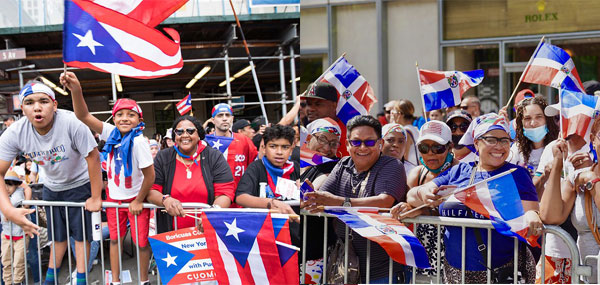
Puerto Rican and Dominican pride in New York City
For six years as a contributing writer for Gotham Gazette I have written almost exclusively on the trajectory and current dynamics of Latino politics in New York. In my first column here, in 2017, I explored how the increase in the Latino electorate was shifting the dynamics of our city’s politics. In the years since, I’ve written about many trends, elections, officials, and more. (I am most grateful to Gotham Gazette and editor Ben Max for giving me a platform from which to explore the important realities of Latinos and politics in New York.)
My writing on this subject stems from a deep passion to give voice to my fellow Latinos, a group that historically has been disenfranchised, rejected, and pushed out from political discourse and participation in the city and state. Indeed, that has also been the national dynamic.
Whether locally or nationally, the struggle is hardly a recent one. Latinos have been fighting for political recognition and representation for nearly a century, ever since large numbers of Puerto Ricans began to arrive in Gotham.
These early efforts, financed by numbers runners (boliteros) and organized by cigar makers (tabaqueros) and pioneering women like Antonia Denis, led in 1937 to the first Latino elected to office in the history of New York, the Puerto Rican Oscar Garcia Rivera, who won the East Harlem Assembly seat. I have shared some of this history in an ongoing series for Gotham Gazette here and here.
While Latinos now comprise almost a third of the population of New York City, and while there has been significant progress since the pioneering efforts of Latinos that came before us, our Latino community continues to struggle for recognition and empowerment. This is perhaps most clearly evident in the dynamics in the “Condado de la Salsa.” The Bronx is the only Latino-majority borough — it is also the poorest borough in the city with the lowest voting participation rates, and it no longer has any borough-wide Latino representation.
My passion to give voice to my people has now led me to embark on a new journey: the founding of a new, independent, nonpartisan think tank focused on Latino politics and policy called The Institute for Latino Politics and Policy (ILPP). The Institute will expand on many of the topics I have explored in my writing at Gotham Gazette and elsewhere over the past six years. Its mission is to promote research, publications, and the education of the wider public on policy and political issues affecting Latinos in New York, including through advocacy and community engagement.
The Institute is inspired by the pioneering efforts of thinkers like Angelo Falcón and José Ramón Sánchez, who decades ago formed their own policy research entity to explore the Latino political and social reality in New York. Falcón, who passed away five years ago, labored as best he could to interpret and describe this reality.
Through the long process of conceiving this think tank, I have been honored to receive the support of many others who have also sought to be a voice for their fellow Latinos — Lucía Gómez (in many ways a Falcón ‘alum’), Aldrin Bonilla, Rev. Ray Rivera, Dr. Sam Cruz, Marlene Peralta, Rev. Fred Davie, Emerita Torres, and still more. This group has been an important sounding board in the exploratory phase of the Institute. A number of educational institutions have also expressed a desire to work collaboratively with The Institute for Latino Politics and Policy.
Over the coming months, the Institute will sponsor virtual and in-person events bringing together academics, policy-makers, faith-based and community leaders for conversation on issues that affect Latino communities. It will also soon begin releasing reports and video content on themes relating to the political and social realities of Latinos in New York.
In sum, The Institute for Latino Politics and Policy is another platform through which I and we can advance the Latino cause and explore the larger context of Latino politics. I hope that you, reader, whether Latino or not, will join me in this effort. You can follow us online at www.latinopolitics.org and on Twitter @InstituteLatino.
***
Eli Valentin is a political analyst and author of the forthcoming book, Reinhold Niebuhr: A Political Life. On Twitter @EliValentinNY.
***
Have an op-ed idea or submission for Gotham Gazette? Email This email address is being protected from spambots. You need JavaScript enabled to view it.




